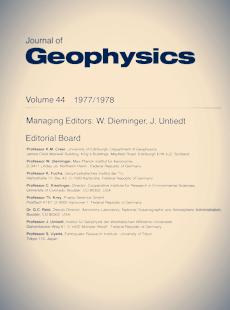Interpretation of wide-angle reflection travel-times in realistic crust-mantle structures
Article Sidebar
Published:
Dec 12, 1977
Keywords:
Explosion seismology,
Wide-angle reflections,
Lateral variations
Volumes

Vols. 1-18 (1924-1944), ISSN 0044-2801
Main Article Content
D. Bamford
Department of Geophysics, University of Edinburgh, UK
Abstract
A method for the interpretation of wide-angle reflection travel-times in laterally varying crust-mantle structures is formulated. A datum correction is first carried out by ray-tracing to remove the effects of refraction above the reflector. The resulting time-distance data may be then expressed in a form which permits, given multiple coverage of the sub-surface, the independent determination of velocity and reflector topography. The method has been tested on model data and found to be effective.
 ARK: https://n2t.net/ark:/88439/y013185
ARK: https://n2t.net/ark:/88439/y013185
Permalink: https://geophysicsjournal.com/article/58
Article Details
How to Cite
Section
References
Bamford, D. (1971) An interpretation of first-arrival data from the Continental Margin Refraction Experiment, Geophys. J. 24:213-229
Bamford, D. (1973) Refraction data in Western Germany-a time-term interpretation. Z. Geophys. 39:907-927
Bamford, D. (1976) MOZAIC time-term analysis. Geophys. J. 44:433-446
Bamford, D. (1977) P, velocity anisotropy in a continental upper mantle. Geophys. J. 49:29-48
Bamford, D., Faber, S., Jacob, B., Kaminski, W., Nunn, K., Prodehl, C., Fuchs, K., King, R., Willmore, P. (1976) A lithospheric seismic profile in Britain-I. Preliminary results. Geophys. J. 44:145-160
Brown, R.J.S. (1969) Normal-moveout and velocity relations for flat and dipping beds and for long offsets. Geophysics 34:180-195
Cerveny, V., Langer, J., Psencik, I. (1974) Computation of geometric spreading of seismic body waves in laterally inhomogeneous media with curved interfaces, Geophys. J. 38:9-20
Clee, T.E., Barr, K.G., Berry, M.J. (1974) Fine structure of the crust near Yellowknife. Can. J. Earth. Sci. ll:1534-1549
Giese, P., Stein, A., Prodehl, C. (Eds.) (1976) Explosion seismology in central Europe- Data and Results, 429 p. Berlin-Heidelberg-New York: Springer-Verlag
Hagedoorn, J.G. (1959) The plus-minus method of interpreting seismic refraction sections. Geophys. Prospecting 7:158-182
Heiland, C.A. (1940) Geophysical exploration, 1013 p. New York: Prentice-Hall
Pavlenkova, N.I. (1973) Interpretation of refracted waves by the reduced travel-time curve method. Phys. Solid Earth 8:544-550
Robinson, J.C. (1970) An investigation of the relative accuracy of the most common normal-moveout expressions in velocity analyses. Geophys. Prospect. 18:352-363
Willmore, P.L., Bancroft, A.M. (1960) The time-term approach to refraction seismology. Geophys. J. 3:419-432
Bamford, D. (1973) Refraction data in Western Germany-a time-term interpretation. Z. Geophys. 39:907-927
Bamford, D. (1976) MOZAIC time-term analysis. Geophys. J. 44:433-446
Bamford, D. (1977) P, velocity anisotropy in a continental upper mantle. Geophys. J. 49:29-48
Bamford, D., Faber, S., Jacob, B., Kaminski, W., Nunn, K., Prodehl, C., Fuchs, K., King, R., Willmore, P. (1976) A lithospheric seismic profile in Britain-I. Preliminary results. Geophys. J. 44:145-160
Brown, R.J.S. (1969) Normal-moveout and velocity relations for flat and dipping beds and for long offsets. Geophysics 34:180-195
Cerveny, V., Langer, J., Psencik, I. (1974) Computation of geometric spreading of seismic body waves in laterally inhomogeneous media with curved interfaces, Geophys. J. 38:9-20
Clee, T.E., Barr, K.G., Berry, M.J. (1974) Fine structure of the crust near Yellowknife. Can. J. Earth. Sci. ll:1534-1549
Giese, P., Stein, A., Prodehl, C. (Eds.) (1976) Explosion seismology in central Europe- Data and Results, 429 p. Berlin-Heidelberg-New York: Springer-Verlag
Hagedoorn, J.G. (1959) The plus-minus method of interpreting seismic refraction sections. Geophys. Prospecting 7:158-182
Heiland, C.A. (1940) Geophysical exploration, 1013 p. New York: Prentice-Hall
Pavlenkova, N.I. (1973) Interpretation of refracted waves by the reduced travel-time curve method. Phys. Solid Earth 8:544-550
Robinson, J.C. (1970) An investigation of the relative accuracy of the most common normal-moveout expressions in velocity analyses. Geophys. Prospect. 18:352-363
Willmore, P.L., Bancroft, A.M. (1960) The time-term approach to refraction seismology. Geophys. J. 3:419-432











